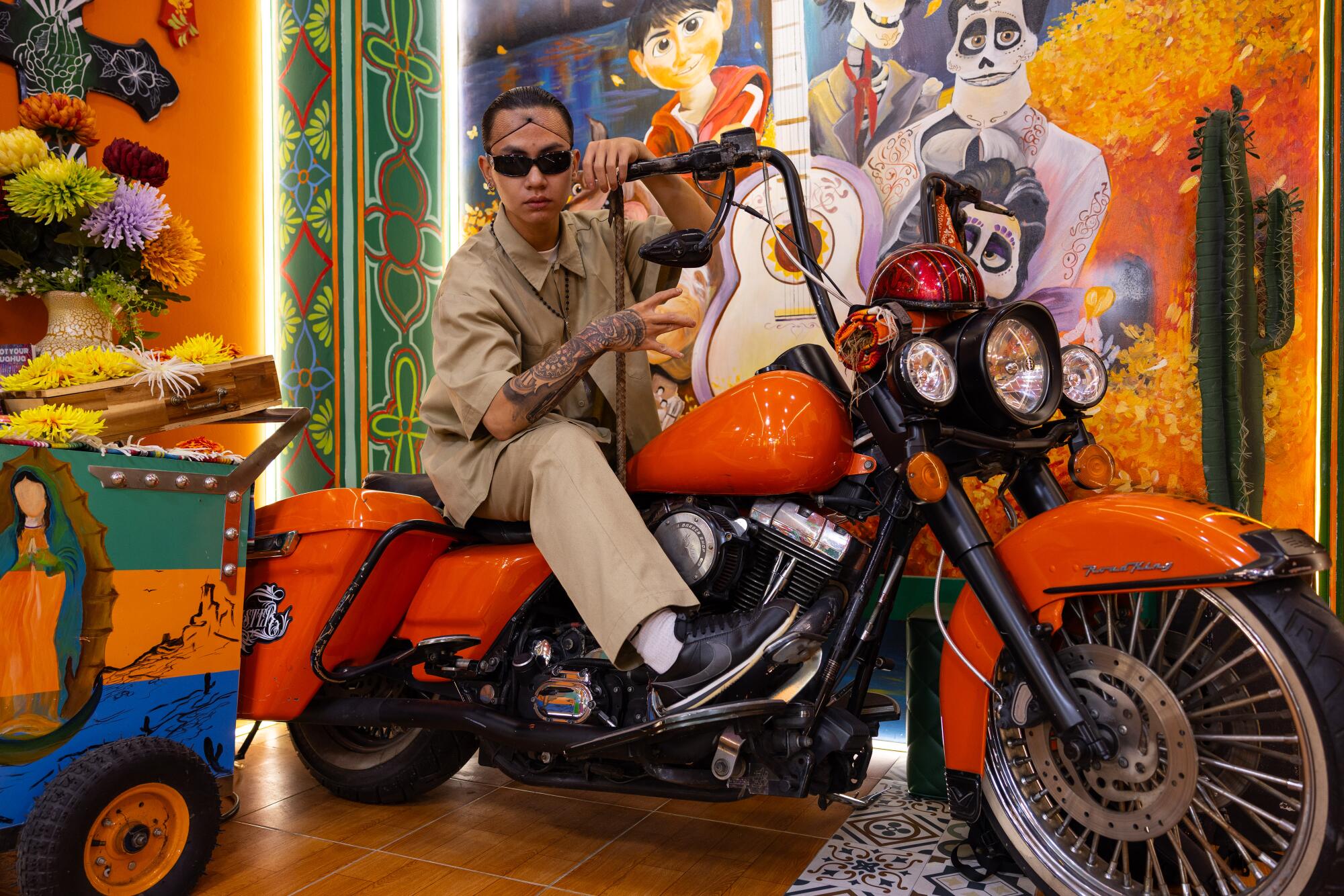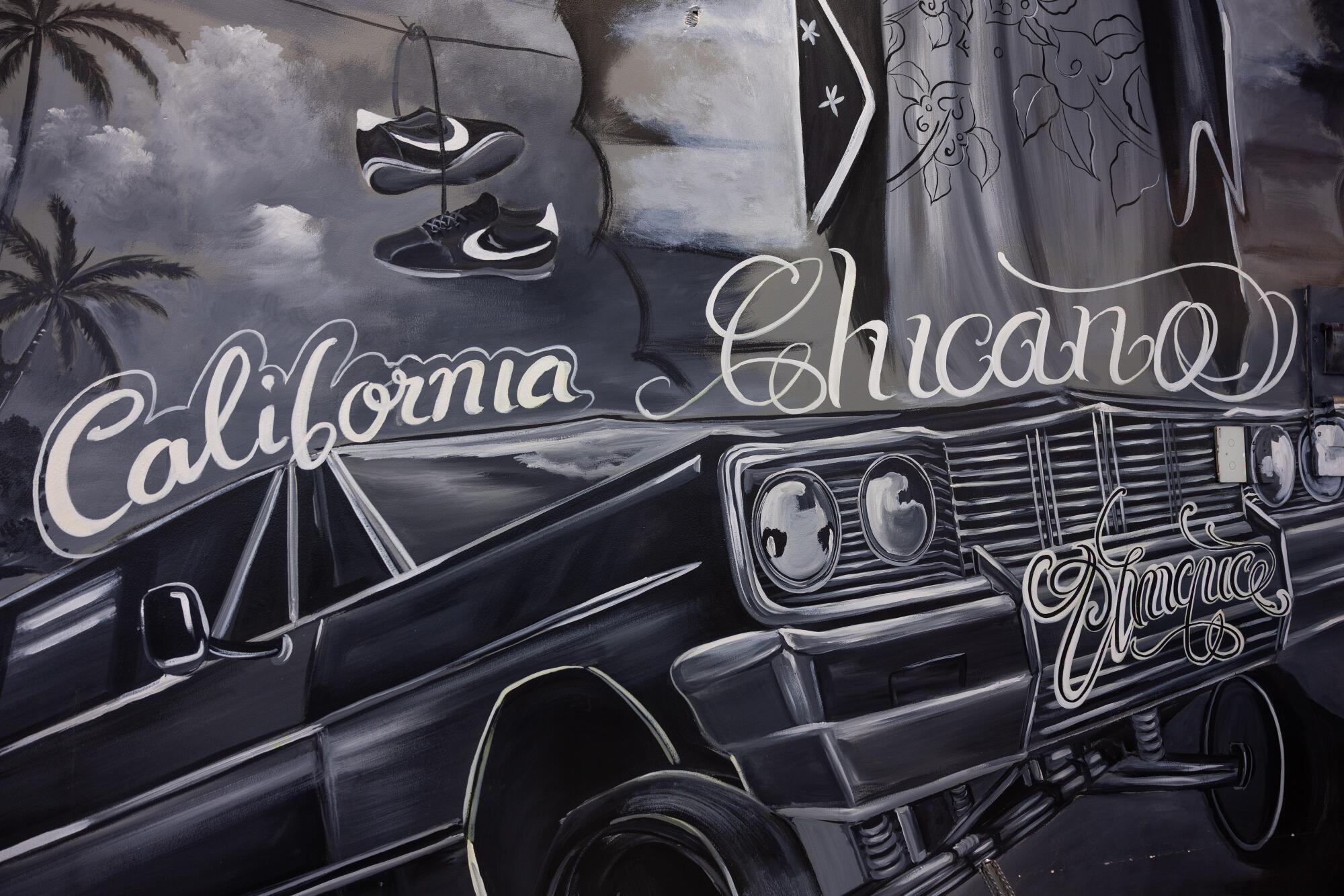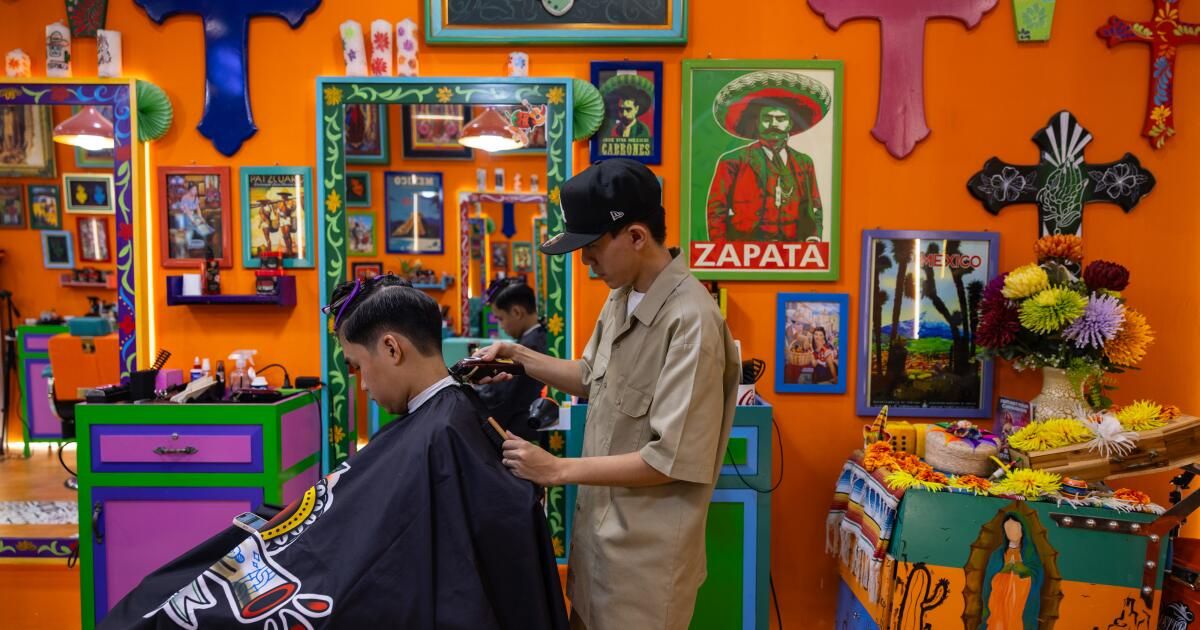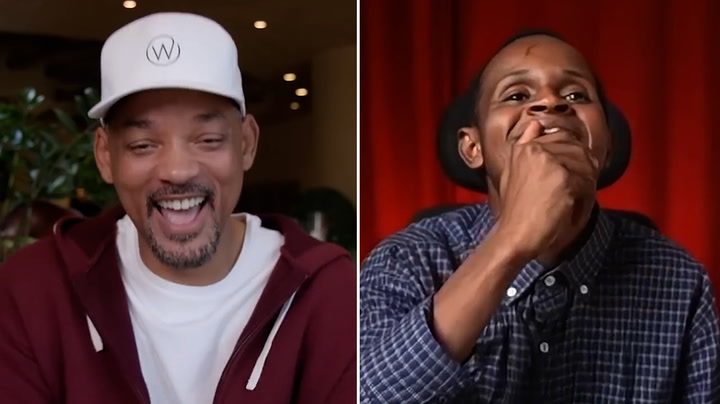Ho Chi Minh City – When Nguyen Phuoc Loc began to venture into the Chicana culture eight years ago, it was simply because he liked the way loose clothes compensated his big head.
Today, Chicano is considered from beginning to end. The 30 -year -old Vietnamese barber has never been in the United States. However, he has filled his life and has worked with tributes to the identity and culture of Mexico.
The back of the barber that handles has a mural of Virgen de Guadalupe, a cactus plant and a Mexican flag. The shoes hang next to their spike wire cords, hanging on two motorcycles.
The head of the Vietnamese barber Nguyen Phuoc Loc is covered with tattoos. The left side is inked with the Spanish word for the family – family.
Even its shaved head is covered with the popular Gothic black letters in the Chicanian culture that spells: family, loyalty, ink in its crown, a large number 6, means its state as the sixth member of a small but increasingly visible community: a local barber band and tattoos artists called Viet Chicanos.
“At first, I was only copying the older boys, their style and everything,” said Loc, 30.
Leaving fashion aside, culture has given Loc a sense of belonging and motivation to work harder in his trade. He began to watch movies full of Chicana culture, such as “American Me” and “Blood in Blood Out”, while using his limited English and translation applications to read on the online movement. He also began to learn Spanish in Duolingo, but said the language has been more difficult to collect.
“If someone comes from Los Angeles, I will ask them everything I can about the Chicana culture,” he said. “It's as if they were tune in with the exact frequency I have been.”
Once a derogatory name for Mexico, the term “Chicano” was recovered as a political identity during the 1960s, born of their struggle for civil rights in the southwest of the United States.
Since then, Chicana identity symbols, such as large street clothing, elaborate tattoos and lowrider cars, have impregnated conventional culture. Subcultures influenced by Chicanas images have emerged in other parts of Asia, such as Thailand, the Philippines and, above all, Japan, where a local love for the Lowriders emerged already emerged in the 1990s.

Armando Rendon, Law, a member of the National Committee of Mexican-American Defamamation, has a table that illustrates a key complaint: that Mexico were dying in Vietnam “at a higher rate, highly disproportionate to their number in the total population of the United States” at a press conference in Washington, DC, in August 1970.
(Bettmann Archive)
Within conservative Asian cultures, clothing and adventurous accessories of the Chicana culture are a large part of the appeal, said Ignacio Lopez Calvo, a professor of UC Merced who has studied the propagation of Lowrider's culture in Japan.
“It is a way of challenging traditional social norms,” he said. “Come the Chicana culture, this rebellion, resistance, independence, and it is a way of expressing yourself, finding an identity and creating community.”
Berta Delgado Melgosa, a Spanish writer who studied Chicana literature written by veterans of the Vietnam War, says that the Chicanian soldiers there identified with certain parts of the Vietnamese culture, while the Chicanian activists protested the racial inequality of the draft in the home.
“When Mexico's soldiers arrived in Vietnam, they saw people who looked like them: their facial features, their clothes, even their hats. They were poor, they worked in the fields and also had a great sense of community and, what is more important, they were also fighting for their lives against US imperialism,” he said.

Nguyen Phuoc Thien, who goes for tea, perches on a motorcycle in the Chicana theme barbership where he works in the city of Ho Chi Minh.
(Chris Trinh / for the times)
The Chicano Vietnam's own “Movement” began 10 years ago, when Nguyen Huynh Thanh Liem opened a barbershop dedicated to the Chicana culture in the city of Ho Chi Minh. Now, the 38 -year -old has about 20 barbers throughout the country, including three Chicano -style stores and barber trains like Loc.
Tran Quoc Viet, a 37 -year -old used car seller, became a regular customer of the Barber of Liem shortly after the first in 2015. At that time, he was intrigued by unusual aesthetics. While never adopted the style of clothing or baggy tattoos, it was impressed with the way the barbers achieved it.
“At that time he could be called rebel,” he said. “There was something bold and nervous about it, which gave me curiosity.”

An Viet Monster Hood Sallon apprentice in Ho Chi Minh City Ink a tattoo in a client.
Many of the Vietnamese attracted by Chicana culture attribute their initial admiration to bright colors and bold contrasts that Liem exhibits in their exclusive stores.
The unconventional touch of Barberes gives them a unique charm, and in recent years, social networks have helped the community to boost their profile and obtain a broader audience beyond Vietnam. Liem has more than 680,000 followers in Tiktok, where he publishes about Chicans in Vietnam. LOC has 1.2 million Tiktok followers; His most popular videos have about 30 million visits.
However, that attention has not been positive, particularly among the major generations of Vietnamese, which are inclined to associate tattoos with gangs and violence.
“In Vietnam, when people see something new or unknown, especially another culture, they don't always appreciate it,” said Nguyen Van Thao, a 35 -year -old tattoo artist who works in another of Liem's stores. “People often make fun or even insult ourselves on social networks, saying things like: 'You are Vietnamese, why are you not Vietnamese? Why do you have to be so?”
Thao began exploring Chicano -style tattoos with Liem when the two met 10 years ago. At that time, its frame of reference mainly came from online images. As they deepened in the Chicana culture, Thao discovered that many other aspects resonated with him, such as the emphasis on family, resistance and respect.
“People often ask me why I chose this culture, but the truth is that I did not choose it. I discovered it and felt more as if I chose,” Thao said. “People come here, they pass the time, they enter, they support what we do. They helped me change my life.”
The stigma associated with tattoos and street clothes in Vietnam has played a role in maintaining the small central community. While information about Chicana culture has increased, those who are firm enough to resist looks and learn about underlying values are the ones that last, Thao said. He speculated that such social scrutiny exerts improper pressure to women who have explored the Chicana community and decided not to stay.
“Actually, there are many people who like culture, I know many who really do it, but they doubt,” he said. “They are afraid of being looks, judged, spoken, attacked. They cannot handle criticism, so they surrender.”

The tattoo artist Nguyen Van Thao poses for a portrait in Viet Monster Hood.
Around 10 dedicated members of the community and their families often enter and leave the Liem Insignia Hall, Viet Monster Hood, to work and socialize.
The Viet Chicans distrust the incorrect type of followers too, which can be in search of a different type of lifestyle. Despite their fierce appearances, many of the barbers who work in Liem stores are soft and humble and reject any perception of violence and crime. They say they want to perpetuate cultural appreciation, instead of appropriation.
“We are inheriting this culture from distance. And in doing so, we choose to take the beautiful parts,” said Thao. “We believe that we can succeed in this way, so that when people look at this culture, they see it connected with real success. And they see that the people who follow them are decent people, and we do not have to be gangsters to be considered a true chicano.”

The Chicano Vietnam “Movement” began 10 years ago, when Nguyen Huynh Thanh Liem opened a barbershop dedicated to the Chicanian culture in the city of Ho Chi Minh. Now, the 38 -year -old has about 20 barbers throughout the country, including three Chicano -style stores.
When the tattoo artist Michael Phan, 25, moved from Munich, Germany, to work for Thao two years ago, his only thought about the Chicana culture was the superficial notion that he is associated with the gangs. But his time at Viet Monster Hood changed that. Now, he likes to cite an “Blood In Blood Out” appointment that is framed on the wall in the living room: “Chicano is not a color, but it is the way you think and the way you live.”
“I love that, because it means you don't have to be in the United States to hug him,” he said.
Learning from Thao has helped Phan grow his followers on social networks and his business, although his clients are still foreigners. While he learned that Chicana and Vietnamese culture has many similarities, such as prioritizing the family, he believes that Vietnamese, including their relatives, may take longer to arrive.
For Nguyen Thi Bich, 60, who was taught that people with tattoos are dangerous, stepping on Viet Monster Hood at the beginning was intimidating. However, he relaxed after seeing how happy the barbers were when they make fun of their 7 -year -old grandson.
“When we went to other Barberes where people were in a bad mood, my little grandson got scared and didn't want to return,” he said. “Now I have been close to people with tattoos, knowing them, I realized that there are all kinds of people everywhere.”
While it is not yet familiar with what Chicano means, he likes the environment in Viet Monster Hood, where the stickers that say “Vietnamese gang” are everywhere, the lazy hip-hop in the background and even in the Bulldog store, Simba, they have drawn tattoos.
“This store feels like one of those places where young people go to rap,” he said. “I've been watching rap on television lately, and I enjoy it quite a lot.”












